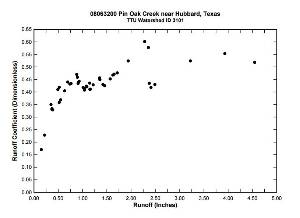Project 0-4405
The Rational Method, Regional Regression Equations, and Site-Specific Flood Frequency Relations
Abstract
A study of 20 undeveloped watersheds with drainage areas from 1.26mi2 to 124mi2, watershed main channel length from 10,300ft to 175,000ft, and dimensionless main channel slope from 0.003 to 0.02, was undertaken to examine the relation between drainage area and appropriate technology for estimating watershed hydrologic response. The rational method, the existing set of regional regression equations, and two new sets of regional regression equations were applied to estimate 5-, 10-, 25-, 50-, and 100-year discharges. In addition, either the fourparameter kappa distribution or the generalized logistic distribution was fit to the annual series of maximum discharges for each watershed. The fitted distribution served as the basis for comparison of the other methods. Watershed area was not a discriminator for appropriate hydrologic method. The Kerby and Kirpich equations for time of concentration produced reasonable results, consistent with results reported in other work. Estimates of discharge using newly developed PRESS-minimized regression equations were subject to less bias than either the regression equations currently in use or the logarithm-transformed equations developed as part of this study. Additional work is required to extend results from the 20 study watersheds to a larger database, including watersheds subject to urbanization.

Project PI: David B. Thompson
Center for Multidisciplinary Research in Transportation (TechMRT)
-
Address
Texas Tech University, Box 41023, Lubbock, TX 79409-1023 -
Phone
806.742.3523 -
Email
techmrt.outreach@ttu.edu
